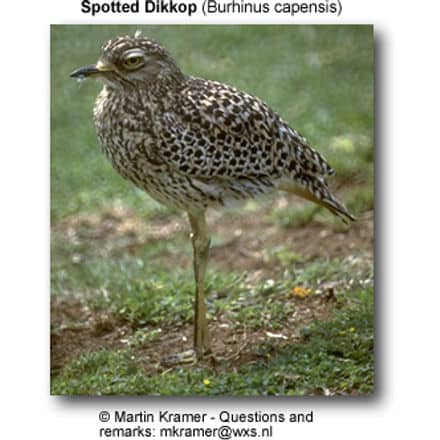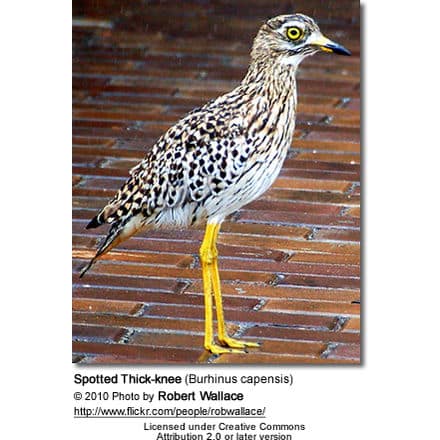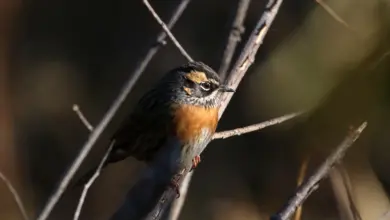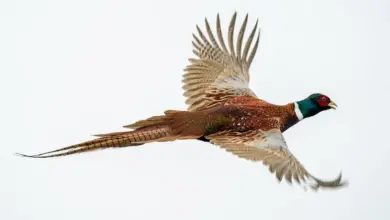Spotted Thick-knees or Spotted Dikkops or Cape Thick-knees
The Spotted Thick-knees (Burhinus capensis) are known by various names, including Spotted Dikkop or Cape Thick-knee, or Gewone Dikkop (in Afrikaans).
Distribution / Range
Its natural range stretches throughout central and western sub-Sahara Africa – where they usually occur in grasslands, semi-deserts, and urban areas.
They are well camouflaged due to their brown black and white plumage that blends well into their environment. This species relies on this camouflage to protect themselves from predators.
They are usually seen singly or in pairs.
Several sub-species are recognized:
- Burhinus capensis capensis (Lichtenstein, 1823) – Nominate Species: Distribution: Kenya S to South Africa, and W from Zambia to Angola.
- Burhinus capensis maculosus (Temminck, 1824) – Distribution: Senegal E to Eritrea and Somalia, and S to Uganda and Kenya
- Burhinus capensis dodsoni (Ogilvie-Grant, 1899) – Distribution: coastal Somalia and South Arabia
- Burhinus capensis damarensis (Reichenow, 1905) – Namibia, Botswana and Southwest South Africa (Cape Province).
Description
This bird stands about 34 – 43 cm (~13- 17 inches) tall and weighs between 365 – 450 grams (~12 – 16 oz). It averages 7.2cm (15 in) in length and its wing span is from 200-245 mm (20-24.5in).
They have brown heads The special characteristics of this species include large yellow eyes and its long greenish-grey / yellowish-tinged legs that appear to have thick knees.
It has a short, plover-like, yellow-brown beak. The arrow-shaped head and part of the back are covered with brownish-black streaks. Spotted Thick-knees have a dark brown streak that stretches from under the eye to the ear feathers and a white streak can be seen below the eye to the cheek. There are white feathers around its eyes.
The upper parts of the body and wings have brown, white, and black splotches. A white bar of plumage separates the wing into sections. Wings are brown and grey, tipped with black, and have white edges surrounding them. The throat is white and the breast is light brown with black streaks. The wedged-shaped tail is tipped in black with some white markings.
Males and females look alike. Juveniles look like adults except they have grey freckled wing feathers.
These birds are capable of flying but prefer walking. When they do fly, they are usually high up and their wing beats are strong and rapid.
Their expected life span is about fifteen years.
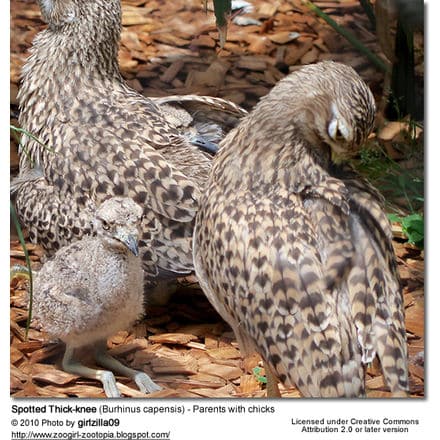
Calls / Vocalizations
Spotted Thick-knees are usually quiet during the daytime but tend to get noisy after sundown as this is the time when they are most active. The repertoire includes several calls, including tche-uuu, pi pi pi pipi, whee-yu-ee. Sometimes they croak.
Diet / Feeding
They feed on grass seeds, insects (butterflies, bees, wasps, locusts, and ants), small lizards, rodents, snails, and crabs. They usually forage for food on the ground.
Breeding
Spotted Thicknees are usually monogamous (have only one mate) and outside the mating season, they tend to be quite mellow. However, males can become aggressive and territorial when they are protecting or defending the young.
They typically nest in spring or early summer. They build nests on the ground with figs, straws, and leaves. They are usually lined with small stones and dry plants. The nest is placed under a bush to protect the eggs and the young from predators.
The hen will lay one to three brown and speckled oval-shaped eggs in each clutch. Both parents take turns incubating the eggs until they hatch (about 26-27 days of incubation).
Stone-Curlew Information … Stone-Curlew Photo Gallery

